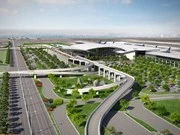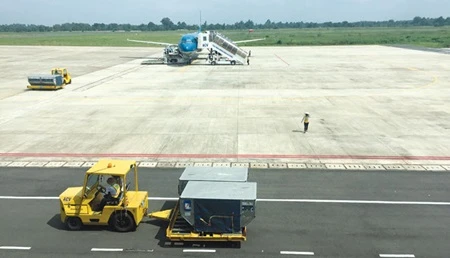Hanoi (VNS/VNA) - Airports with modern infrastructure that can serve as international hubs had the potential to become major drivers for national socio-economic development, said experts at a recent conference held to discuss the sustainable development of Vietnam’s airports in Hanoi.
Airports that had successfully transformed into international hubs produced a kind of ripple effect that significantly strengthened socio-economic development, said Dang Huy Dong, head of the Institute for Research Planning and Development and the organiser of the conference.
In the best-case scenario, State investment in infrastructure could be quickly recuperated while the airports continued to produce economic benefits.
“On the other hand, inefficient investments that lack foresight may become heavy financial burdens on the State budget,” Dong said, citing a stark contrast between Germany’s Frankfurt International Airport – one of Europe’s major aviation transport hubs - and Berlin International Airport, an ill-fated project that just can’t seem to take off after a decade of construction.
International experts discussed numerous issues related to the development of national gateway airports and how to secure the needed investment for infrastructure without creating too large a financial burden on the State.
They recommended the planning and implementation of airport projects must be completed with a long-term vision in the minds of policymakers. The airports must be well-connected with other existing means of transport to maximise the impact on socio-economic growth.
In Vietnam, Long Thanh International Airport which is to be constructed on the outskirts of Ho Chi Minh City, has been earmarked to be developed into a connecting hub. Lai Xuan Thanh, chairman of the Airport Corporation of Vietnam (ACV), said the airport would serve as a national gateway as well as a major transport hub for aviation companies in the region.
“Of the 22 airports in the country, only three meet the requirements to become national gateway airports: Noi Bai International Airport, Long Thanh-Tan Son Nhat International Airport and Da Nang International Airport,” Thanh said.
Large airports were usually under the management of State-owned enterprises as they were not only socio-economic development drivers but also strategic points for national defence and security, he added, saying digitalisation and technology were to be the focus of Long Thanh International Airport’s management model./.
Airports that had successfully transformed into international hubs produced a kind of ripple effect that significantly strengthened socio-economic development, said Dang Huy Dong, head of the Institute for Research Planning and Development and the organiser of the conference.
In the best-case scenario, State investment in infrastructure could be quickly recuperated while the airports continued to produce economic benefits.
“On the other hand, inefficient investments that lack foresight may become heavy financial burdens on the State budget,” Dong said, citing a stark contrast between Germany’s Frankfurt International Airport – one of Europe’s major aviation transport hubs - and Berlin International Airport, an ill-fated project that just can’t seem to take off after a decade of construction.
International experts discussed numerous issues related to the development of national gateway airports and how to secure the needed investment for infrastructure without creating too large a financial burden on the State.
They recommended the planning and implementation of airport projects must be completed with a long-term vision in the minds of policymakers. The airports must be well-connected with other existing means of transport to maximise the impact on socio-economic growth.
In Vietnam, Long Thanh International Airport which is to be constructed on the outskirts of Ho Chi Minh City, has been earmarked to be developed into a connecting hub. Lai Xuan Thanh, chairman of the Airport Corporation of Vietnam (ACV), said the airport would serve as a national gateway as well as a major transport hub for aviation companies in the region.
“Of the 22 airports in the country, only three meet the requirements to become national gateway airports: Noi Bai International Airport, Long Thanh-Tan Son Nhat International Airport and Da Nang International Airport,” Thanh said.
Large airports were usually under the management of State-owned enterprises as they were not only socio-economic development drivers but also strategic points for national defence and security, he added, saying digitalisation and technology were to be the focus of Long Thanh International Airport’s management model./.
VNA























